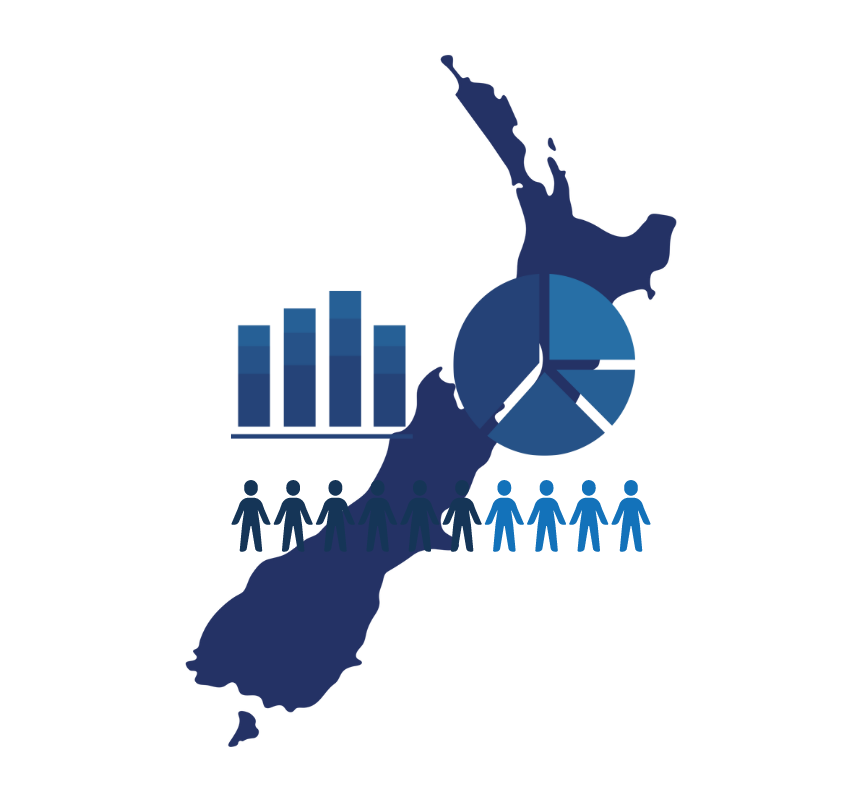NEW ZEALAND
New Zealand Census 2018
From Data n Dashboards
The official count of people and dwellings in New Zealand

Data Overview
The New Zealand Census of Population and Dwellings is the official count of people and dwellings in New Zealand.
This data provides a snapshot of New Zealand at a point in time and helps to tell the story of its social and economic change. The 2018 Census, held on Tuesday 6 March, was the 34th New Zealand Census of Population and Dwellings. The first official census was run in 1851, and since 1877 there has been a census every five years, with only four exceptions.
Uses:
Census information is used by government agencies, local authorities, businesses, community organisations, and the public for developing and implementing new policies, research, planning, and decision-making. It helps decision making around how to best use public funding, especially in areas of health, education, housing, and transport. The census is also the primary source of information used for deciding the number of general and Māori electorates, along with data from the corresponding Māori Electoral Option.
This data listing also comprises of Iwi affiliation estimated counts that present the number of people identified as being of Māori descent in the 2018 Census. Iwi affiliation estimated counts were produced following a joint initiative between Stats NZ and Data Iwi Leaders Group (Data ILG). For many purposes, the 2018 iwi estimates provide a more relevant and up-to-date picture than the continued use of 2013 Census iwi data. These iwi estimates are not official 2018 Census counts, and the quality of these estimates ranges from moderate to poor depending on how the data is used.
For more information regarding Iwi data census 2018: https://www.stats.govt.nz/information-releases/iwi-affiliation-estimated-counts-2018
Data is provided by Statistics New Zealand
- Education and training
- Ethnicity, culture, and identity
- Families and households
- Health
- Housing
- Māori
- Iwi by affiliation and grouping
- Population and migration
- Travel to work and education
- Work, income, and unpaid activities
- Regional council
- Territorial authority (cities and districts)
- Auckland local board
- District health board area
- Urban rural area
- Statistical area 2 (small areas)
- Statistical area 1 (very small areas)
Cloud Region Availability
US West (Oregon)
Canada (Central)
US East (N. Virginia)
US East (Ohio)
US East (Commercial Gov - N. Virginia)
US Gov East 1 (Fedramp High Plus)
US Gov West 1
US Gov West 1 (DoD)
US Gov West 1 (Fedramp High Plus)
Asia Pacific (Jakarta)
Asia Pacific (Mumbai)
Asia Pacific (Osaka)
Asia Pacific (Seoul)
Asia Pacific (Singapore)
Asia Pacific (Sydney)
Asia Pacific (Tokyo)
EU (Frankfurt)
EU (Ireland)
EU (London)
EU (Stockholm)
EU (Zurich)
EU (Paris)
South America (São Paulo)
Canada Central (Toronto)
Central US (Iowa)
East US 2 (Virginia)
South Central US (Texas)
US Gov Virginia
US Gov Virginia (FedRAMP) High Plus
West US 2 (Washington)
Australia East (New South Wales)
Central India (Pune)
Japan East (Tokyo, Saitama)
Southeast Asia (Singapore)
UAE North (Dubai)
North Europe (Ireland)
Switzerland North (Zurich)
UK South (London)
West Europe (Netherlands)
US Central 1 (Iowa)
US East 4 (N. Virginia)
Europe West 2 (London)
Europe West 4 (Netherlands)
Category
Demographics
Refreshes
Static
Access
Available on request
Geographic Coverage
New Zealand (by City)
Time Coverage
5 March, 2013 - 6 March, 2018

